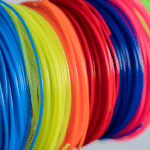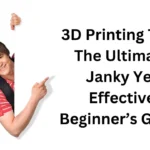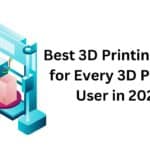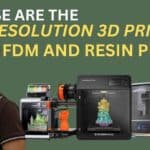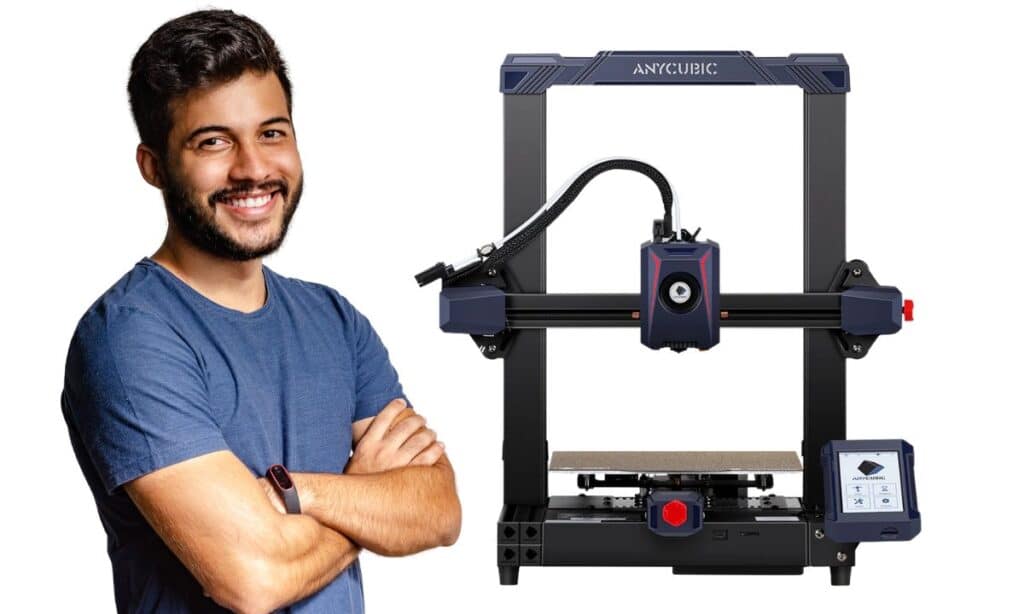
The Phrozen Sonic Mini 8K S wins for artistic 3D-printed decor, while the Bambu Lab P1S excels for functional pieces—perfect picks to unlock your creativity with the right printer.
3D printing isn’t just a tool—it’s a gateway to turning imagination into tangible art, functional prototypes, or even a thriving business. But with over 200+ models on the market, selecting the right printer can feel paralyzing. This guide isn’t just another listicle; it’s a deep dive into the nuances of 3D printing, tailored for decor enthusiasts, makers, and professionals. By the end, you’ll know exactly which printer aligns with your goals, budget, and the stunning projects you envision.
Affiliate Disclosure
We participate in Amazon affiliate programs, earning fees from qualifying purchases via links at no extra cost to you. It’s how we keep this blog rolling and my 3D printers buzzing with fresh filament for reviews like this one!
Get the Creality Ender 3 V3 SE ($259) on Amazon for budget-friendly decor printing!
How to Choose a 3D Printer in 7 Steps
Chapter 1: The Foundation—Understanding Your Needs
1.1 What Are You Creating? (Project-Based Decision Making)
Your projects dictate your printer. Let’s break it down:
- Home Decor & Art: Vases, wall art, figurines
- Ideal Printers: Resin (e.g., Phrozen Sonic Mini 8K S) for intricate details, or FDM with 0.2mm nozzles for textured finishes.
- Pro Tip: Use silk PLA or marble-effect filaments for luxurious finishes. For inspiration, explore our guide to 3D-printed vases that hold water or DIY 3D-printed decor.
- Functional Parts: Hooks, gears, tool organizers
- Ideal Printers: FDM with PETG/ABS compatibility (e.g., Bambu Lab P1S) or IDEX printers for multi-material durability.
- Professional Prototypes: Architectural models, product mockups
- Ideal Printers: High-speed CoreXY (e.g., Creality Ender 3 V3 SE) or large-format resin (Phrozen Sonic Mega 8K).
Case Study: A jewelry designer doubled sales by switching to the Phrozen Sonic Mini 8K S for hyper-detailed pendants.
1.2 Skill Level: Are You a Beginner, Hobbyist, or Pro?
- First-Time Users: Prioritize plug-and-play printers (e.g., Anycubic Kobra 3 Combo) with auto-bed leveling and pre-tuned profiles. Check our best beginner 3D printers under $500 for budget-friendly options.
- Advanced Makers: Opt for open-source models (e.g., Creality K1C) for firmware tinkering and mods.
- Businesses: Invest in industrial-grade printers (e.g., Formlabs Form 3L) for consistency and bulk production.
Pro Tip: Beginners should avoid resin printers initially—they require mastering post-processing. Start with FDM and our 3D printing tips for newbies.
1.3 Space & Environment
- Small Spaces: Desktop resin printers (e.g., Anycubic Photon Mono 4) or compact FDM (Prusa MINI+).
- Noise Sensitivity: Resin printers (quiet) vs. FDM (50–60 dB). Enclosures reduce noise for FDM—learn more in our 3D printer enclosures guide.
- Ventilation Needs: Resin requires HEPA filters and airflow; FDM with ABS needs a sealed enclosure.
Example: A home-based creator used the Creality K1 SE in a spare closet with an enclosure to minimize noise.
Chapter 2: Printer Types Demystified—Beyond the Basics
2.1 FDM Printers: The Workhorse of 3D Printing
- How They Work: Melted filament layered via a heated nozzle.
- Best For: Large decor, functional parts, cost-effective prototyping.
- Hidden Gems:
- Direct Drive vs. Bowden: Direct drive (e.g., FLASHFORGE Adventurer 5M) handles flexible filaments; Bowden (e.g., Ender 3 V3) is lighter for speed. Compare models like the Creality K1 vs K1 SE for speed and reliability.
- Enclosed vs. Open Frame: Enclosed (e.g., FLASHFORGE Adventurer 5M Pro) prevents warping with ABS.
Material Deep Dive:
- PLA: Ideal for decorative items like 3D-printed lighting.
- PETG: Durable enough for custom kitchen organizers.
- TPU: Perfect for flexible phone cases.
2.2 Resin Printers (SLA/DLP): Precision Redefined
- How They Work: UV light cures liquid resin layer by layer.
- Best For: Miniatures, jewelry, dental models.
- The Catch: Post-processing (washing/curing) adds 30% more time. Use tools from our top 15 must-have 3D printing tools for flawless results.
- Game-Changer:8K vs. 4K Resin Printers
- 8K (e.g., Phrozen Sonic Mini 8K S): 22µm pixel size for hyper-detailed art.
- 4K (e.g., Elegoo Mars 4): Budget-friendly for small decor.
Pro Tip: Pair your resin printer with the Elegoo Mercury Plus 2.0 for streamlined post-processing.
2.3 Specialty Printers: When Standard Isn’t Enough
- CoreXY Printers (e.g., FLASHFORGE AD5M): Faster, stable prints for large-scale decor.
- IDEX Printers (e.g., Prusa MK4S): Dual extruders for multi-color vases or dissolvable supports.
- SLS Printers (e.g., Formlabs Fuse 1): Nylon sintering for unbreakable functional parts.
Industrial Spotlight: The Markforged Metal X prints stainless steel parts for aerospace applications.
Chapter 3: The 10 Must-Check Features (Avoid Buyer’s Remorse)
3.1 Build Volume: Size Matters
- Small (120x120x120mm): Mini decor, jewelry.
- Medium (220x220x250mm): Most home decor (e.g., lamps, planters).
- Large (300x300x300mm+): Furniture components, life-sized sculptures.
Case Study: A furniture designer used the Creality K1 Max to print modular shelving components.
3.2 Material Compatibility: Unlock Versatility
- FDM Filaments:
- PLA (easy, biodegradable)
- PETG (durable, food-safe)
- TPU (flexible phone cases)
- Compare options in our Ultimate 3D Filament Tier List.
- Resin Types:
- Standard (e.g., Siraya Tech Fast)
- Water-Washable (no IPA needed)
- Ceramic Hybrid (stone-like finishes).
Pro Tip: Use a filament dryer to prevent moisture-related print failures.
3.3 Print Speed vs. Quality: The Delicate Balance
- Speed Modes: Bambu Lab’s “Ludicrous Mode” cuts print time by 50% but may reduce surface smoothness.
- Layer Height: 0.1mm (high detail) vs. 0.3mm (draft mode).
Example: A cosplayer used the Bambu Lab X1C in “Ludicrous Mode” to print armor pieces overnight.
3.4 Connectivity: From SD Cards to Cloud
- Wi-Fi/Ethernet: Remote monitoring via Bambu Handy or Prusa Connect.
- Cameras: Check print progress from your phone.
Pro Tip: Use OctoPrint with a Raspberry Pi for DIY wireless printing.
3.5 Upgradability: Future-Proof Your Investment
- Modular Hotends: Swap nozzles (0.2mm for detail, 0.8mm for speed).
- Firmware: Klipper for speed tweaks, Marlin for reliability.
- Explore best 3D printer upgrades for beginners to enhance performance.
3.6 Safety & Sustainability
- Resin Safety: Gloves, masks, and eco-friendly resins (e.g., Phrozen Aqua-Gray 8K).
- FDM Recycling: Grinders like Filastruder turn scraps into new filament.
Eco-Friendly Hack: Use recycled PETG for sustainable planters.
Chapter 4: Budget Breakdown—From 200 to 10,000+
4.1 Entry-Level (200–500)
- FDM: Creality Ender 3 V3 SE (reliable, moddable).
- Resin: Anycubic Photon Mono 4 (10K detail).
- Best For: Beginners testing the waters.
Pro Tip: Pair the Ender 3 with affordable filaments like PLA+.
4.2 Mid-Range (500–1,500)
- FDM: Bambu Lab A1 Mini (multi-color, AI monitoring).
- Resin: Phrozen Sonic Mini 8K S (22µm precision).
- Best For: Serious hobbyists and small businesses.
Case Study: A small business used the Flashforge Adventurer 5M to prototype custom decor for clients.
4.3 Prosumer (1,500–3,500)
- FDM: Prusa XL (5-toolhead for multi-material).
- Resin: Formlabs Form 3+ (dental/medical-grade).
- Best For: Professional studios and engineers.
Example: A dental lab used the Form 3+ to print medical-grade models.
4.4 Industrial ($5,000+)
- SLS: Sinterit Lisa X (nylon prototyping).
- Metal: Markforged Metal X (stainless steel parts).
- Best For: Aerospace, automotive, and manufacturing.
Chapter 5: Real-World Testing—How to Vet Your Top Choices
5.1 Print Benchmark Models
- 3DBenchy: Tests overhangs, bridges, and dimensional accuracy.
- Voron Cube: Measures precision and Z-axis stability.
Pro Tip: Download free models from Printables to test your printer.
5.2 Visit Local Makerspaces
Hands-on testing trumps specs. Example:
- Case Study: A decor artist switched from Ender 3 to Prusa MK4 after testing both at a makerspace, cutting failed prints by 70%.
5.3 Leverage Communities
- Reddit’s r/3DPrinting and Discord groups offer unfiltered reviews.
- Pro Tip: Search “[Printer Model] + clogs” to uncover recurring issues.
Resource: Our 3D printer comparison tool simplifies side-by-side analysis.
Chapter 6: Software & Post-Processing—The Unsung Heroes
6.1 Slicers: Cura vs. PrusaSlicer vs. Bambu Studio
- Cura: Custom supports, ideal for organic shapes.
- Bambu Studio: Cloud integration for X1C users.
- Explore our best slicing software for 3D printing for deeper insights.
6.2 CAD Tools for Decor Design
- Free: Tinkercad (beginners), Blender (organic shapes).
- Pro: Fusion 360 (parametric designs).
Case Study: A creator used Blender to design a 3D-printed dragon sculpture.
6.3 Post-Processing Perfection
- Sanding & Priming: Achieve glass-like finishes on FDM prints.
- Resin Curing: Mercury X Bundle for scratch-free results.
- Don’t miss our resin printer maintenance guide for long-lasting machines.
Pro Tip: Use epoxy resin to waterproof functional prints.
Chapter 7: The Future of 3D Printing—Trends to Watch
- AI-Driven Printers: Bambu Lab’s lidar detects failures in real-time.
- Recycled Filaments: Polymaker PolyTerra (plant-based PLA).
- Multi-Material Magic: Prusa XL’s 5-in-1 toolheads for gradient decor.
Industry Insight: NASA uses 3D printing in space to manufacture tools on-demand.
If you’re looking for printers that can handle multiple colors or materials, check out our guide to the top multimaterial 3D printers for 2025.
FAQs: Your Burning Questions, Answered
Q: Can I print food-safe bowls?
Only with FDA-approved PETG and dedicated stainless steel nozzles. Learn more in are 3D-printed cups safe?.
How long do 3D printers last?
2–5 years with maintenance. Replace belts, nozzles, and LCD screens (resin) annually.
Which printer is best for selling decor online?
Resin (Phrozen 8K) for miniatures; FDM (Bambu X1C) for large, bold pieces. Dive into selling 3D printed decor online for tips.
Are 3D printers worth it for home use?
Absolutely! Start with our best home-use printers to craft custom decor.
Conclusion: Your Perfect Printer Awaits
Whether you’re crafting delicate figurines or industrial prototypes, the right 3D printer is out there. For 3DPrintedDecor.com readers, we recommend starting with a Phrozen Sonic Mini 8K S for art or a Bambu Lab P1S for functional decor. Remember, your printer is a partner—invest time in learning it, and it’ll reward you with limitless creativity.
Ready to Explore Further?
- Dive into our 3D Printing Materials Guide.
- Join our Pinterest group for exclusive project templates!
Get the Creality Ender 3 V3 SE ($259) on Amazon for budget-friendly decor printing!

